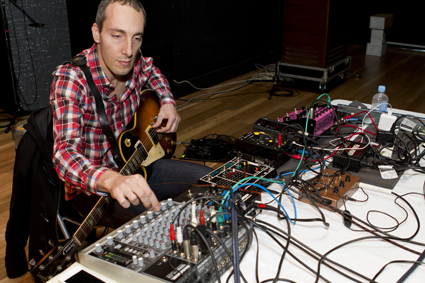flight-or-fight listening
matthew lorenzon: oren ambarchi, aurora festival of living music

Oren Ambarchi, performing as part of Noise Duo
photo John Humphreys
Oren Ambarchi, performing as part of Noise Duo
IT TAKES A COUPLE OF HOURS TO GET FROM SYDNEY’S CITY CENTRE TO THE JOAN SUTHERLAND PERFORMING ARTS CENTRE IN PENRITH. WALKING THROUGH THE SUBURB’S SHOPPING PRECINCT BROUGHT ME IN CONTACT WITH SUBURBAN CULTURE THE LIKES OF WHICH I HAVEN’T SEEN SINCE I LIVED IN ADELAIDE’S DEEP SOUTH.
I remembered that getting into noise in a suburban environment was both a natural progression through pop’s quirkier and darker sides, as well as a reaction against what appeared to be a sterile and hopeless environment. In city centres short noise gigs can become one stop in a long night’s carousing, but by the time I was seated in the Q Theatre at the Joan, I was in no way under the delusion that I was just ‘popping in’ to catch a little noise before kicking on. Locals—apart from the elderly couple who left after five minutes—seemed similarly committed to the rare performance.
Sitting back in the cinema-style seats of the amphitheatre, I had an almost bird’s eye view of the technological forces shipped out for the gig. Noise is not only heavy because it is sonically loud and dense, but the physical weight of the equipment used to generate it gives a sense of permanence and authority to its performance. Framed by giant speaker boxes like two ancient monoliths, Oren Ambarchi walked silently on stage, picked up his guitar and sat down to his table of mixers, pedals, springs and synthesisers.
The drone began to build and undulate. Ambarchi’s noise struck me as a sonic equivalent of erasure in painting. Shapes introduced into the rig from the guitar are rendered barely discernible between a bed of deep tone and scratchy, high-end interference. The result is a constantly shifting and incredibly detailed sonic canvas that holds the listener in an ecstatic, flight-or-fight, deer-in-the-headlights trance. As the set progressed Ambarchi’s erased shapes became clearer, taking the form of the open tones and harmonics of the guitar strings.
To get the idea of open strings and harmonics think of the bright sound of a bugle, a hunting call or even the warble of seagulls. The heroic harmonic series provided a contrast to the minor modes of most metal and drone. What was this image obscured by the apocalyptic, deteriorating sonic wash? A flag? A parade? An 80s guitar solo? Was this exuberant drone in fact humorous? The intrusion of this unexpected tonality made me suddenly aware of the Aurora festival’s daring effort in taking performers and audiences out of their comfort zones, both physically and aesthetically.
Emerging from the half-hour of drone in the hulking Joan Sutherland Performing Arts Centre, it seemed incongruous for Ambarchi to saunter off with a shrug as though he had somewhere else to go, then creep back on stage to pack up his equipment. A crowd gathered around to taxonomise Ambarchi’s boxes, switches and leads before dispersing into the very different noise of a Thursday night in Penrith.
Aurora Festival of Living Music: Oren Ambarchi, Joan Sutherland Performing Arts Centre, Penrith, NSW, May 10; www.auroranewmusic.com.au
RealTime issue #109 June-July 2012 pg. web






